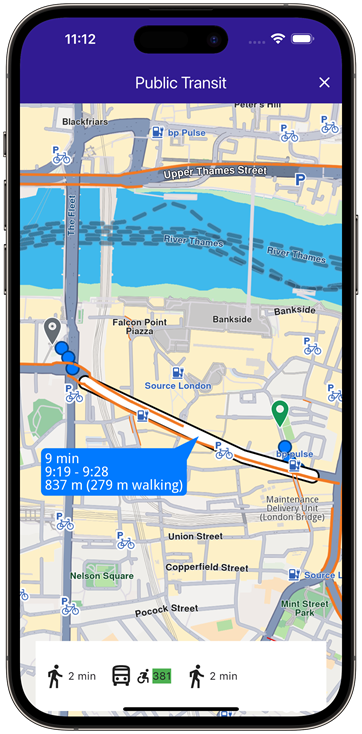Public Transit
This example demonstrates how to create a Flutter app that displays public transit routes using Maps SDK for Flutter. Users can calculate and visualize routes between two landmarks.
How It Works
The example app demonstrates the following features:
- Display a map.
- Calculate a public transport route between two coordinates.
- Display computed route on map along with transit segments at the bottom of the screen.
 |
|---|
| Public Transit Route |
UI and Map Integration
This code sets up the main screen with a map and functionality for calculating and displaying public transit routes.
class MyApp extends StatelessWidget {
const MyApp({super.key});
Widget build(BuildContext context) {
return const MaterialApp(
debugShowCheckedModeBanner: false,
title: 'Public Transit',
home: MyHomePage(),
);
}
}
class MyHomePage extends StatefulWidget {
const MyHomePage({super.key});
State<MyHomePage> createState() => _MyHomePageState();
}
class _MyHomePageState extends State<MyHomePage> {
late GemMapController _mapController;
TaskHandler? _routingHandler;
List<PTRouteSegment>? _ptSegments;
void dispose() {
GemKit.release();
super.dispose();
}
Widget build(BuildContext context) {
return Scaffold(
appBar: AppBar(
backgroundColor: Colors.deepPurple[900],
title: const Text('Public Transit', style: TextStyle(color: Colors.white)),
actions: [
if (_routingHandler == null && _ptSegments == null)
IconButton(
onPressed: () => _onBuildRouteButtonPressed(context),
icon: const Icon(Icons.route, color: Colors.white),
),
if (_routingHandler != null)
IconButton(
onPressed: () => _onCancelRouteButtonPressed(),
icon: const Icon(Icons.stop, color: Colors.white),
),
if (_ptSegments != null)
IconButton(
onPressed: () => _onClearRoutesButtonPressed(),
icon: const Icon(Icons.clear, color: Colors.white),
),
],
),
body: Stack(
alignment: AlignmentDirectional.bottomCenter,
children: [
GemMap(
key: ValueKey("GemMap"),
onMapCreated: _onMapCreated,
appAuthorization: projectApiToken,
),
if (_ptSegments != null)
Padding(
padding: const EdgeInsets.all(8.0),
child: Container(
height: MediaQuery.of(context).size.height * 0.1,
width: MediaQuery.of(context).size.width * 0.9,
color: Colors.white,
child: Row(
// Build a TransitSegment to display data from each segment
children:
_ptSegments!.map((segment) {
return TransitSegment(segment: segment);
}).toList(),
),
),
),
],
),
);
}
Future<void> _onMapCreated(GemMapController controller) async {
_mapController = controller;
await _registerRouteTapCallback();
}
// Additional methods for route calculation...
}
Route Calculation
This code handles the route calculation and updates the UI with the calculated segments.
void _onBuildRouteButtonPressed(BuildContext context) {
final departureLandmark = Landmark.withLatLng(latitude: 51.505929, longitude: -0.097579);
final destinationLandmark = Landmark.withLatLng(latitude: 51.507616, longitude: -0.105036);
final routePreferences = RoutePreferences(transportMode: RouteTransportMode.public);
_showSnackBar(context, message: "The route is being calculated.");
_routingHandler = RoutingService.calculateRoute(
[departureLandmark, destinationLandmark],
routePreferences,
(err, routes) {
_routingHandler = null;
ScaffoldMessenger.of(context).clearSnackBars();
if (err == GemError.success) {
final routesMap = _mapController.preferences.routes;
for (final route in routes) {
routesMap.add(
route,
route == routes.first,
label: route == routes.first ? route.getMapLabel() : null,
);
}
_mapController.centerOnRoutes(routes: routes);
final ptRoute = routes.first.toPTRoute();
final ptSegments =
ptRoute!.segments.map((seg) => seg.toPTRouteSegment()).toList();
setState(() {
_ptSegments = ptSegments;
});
}
},
);
setState(() {});
}
Transit Segment Display
This widget displays transit segments and relevant information about each route leg.
class TransitSegment extends StatelessWidget {
final PTRouteSegment segment;
const TransitSegment({super.key, required this.segment});
Widget build(BuildContext context) {
return Padding(
padding: const EdgeInsets.symmetric(horizontal: 8.0),
child: segment.transitType == TransitType.walk
? Row(
children: [
const Icon(Icons.directions_walk, size: 35.0),
Text(convertDuration(segment.timeDistance.totalDistanceM)),
],
)
: Row(
children: [
const Icon(Icons.directions_bus_outlined, size: 35.0),
if (segment.hasWheelchairSupport) const Icon(Icons.accessible_forward),
Container(color: Colors.green, child: Text(segment.shortName)),
],
),
);
}
}
Utility Functions
These utility functions convert distances and durations into user-friendly formats.
String convertDistance(int meters) {
if (meters >= 1000) {
double kilometers = meters / 1000;
return '${kilometers.toStringAsFixed(1)} km';
} else {
return '${meters.toString()} m';
}
}
String convertDuration(int seconds) {
int hours = seconds ~/ 3600;
int minutes = (seconds % 3600) ~/ 60;
String hoursText = (hours > 0) ? '$hours h ' : '';
String minutesText = '$minutes min';
return hoursText + minutesText;
}
Displaying Route Information
This code defines an extension on the Route class that calculates and formats the distance and duration of the route for display on the map.
// Define an extension for route for calculating the route label which will be displayed on map.
extension RouteExtension on Route {
String getMapLabel() {
// Get total distance and total duration from time distance.
final totalDistance =
getTimeDistance().unrestrictedDistanceM +
getTimeDistance().restrictedDistanceM;
final totalDuration =
getTimeDistance().unrestrictedTimeS + getTimeDistance().restrictedTimeS;
// Convert the route to a public transit route (PTRoute).
final publicTransitRoute = toPTRoute();
if (publicTransitRoute == null) {
return "";
}
// Get the first and last segments of the route.
final firstSegment = publicTransitRoute.segments.first.toPTRouteSegment();
final lastSegment = publicTransitRoute.segments.last.toPTRouteSegment();
// Get departure and arrival times from the segments.
final departureTime = firstSegment.departureTime;
final arrivalTime = lastSegment.arrivalTime;
// Calculate total walking distance (first and last segments are typically walking).
final totalWalkingDistance =
firstSegment.timeDistance.totalDistanceM +
lastSegment.timeDistance.totalDistanceM;
String formattedDepartureTime = "";
String formattedArrivalTime = "";
if (departureTime != null && arrivalTime != null) {
// Format departure and arrival times.
formattedDepartureTime =
'${departureTime.hour}:${departureTime.minute.toString().padLeft(2, '0')}';
formattedArrivalTime =
'${arrivalTime.hour}:${arrivalTime.minute.toString().padLeft(2, '0')}';
}
// Build the label string with the route's details.
return '${convertDuration(totalDuration)}\n' // Total duration
'$formattedDepartureTime - $formattedArrivalTime\n' // Time range
'${convertDistance(totalDistance)} ' // Total distance
'(${convertDistance(totalWalkingDistance)} walking)\n' // Walking distance
'${publicTransitRoute.publicTransportFare}'; // Fare
}
}
Flutter Examples
Maps SDK for Flutter Examples can be downloaded or cloned with Git.